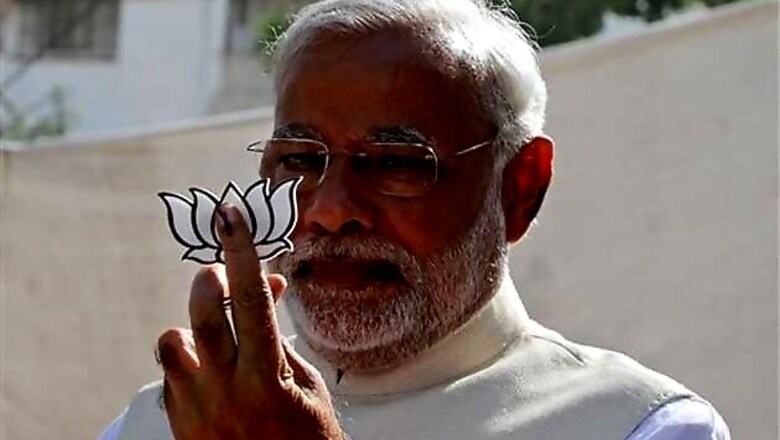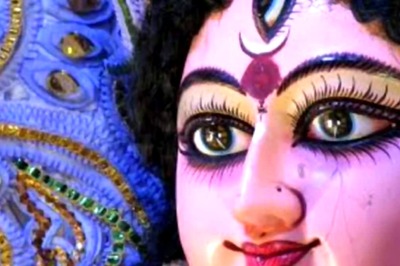
views
The great and terrible Alphonse Capone, say historians and other people sometimes accused of living in the past, was a gangster. That's to put it mildly. For years he ran the Chicago underworld of the 1920s with an iron fist.
What got him in the end was not murder or smuggling or any respectable gangster-like crime, but tax evasion.
Not even the bitterest enemies of Narendra Modi, who perhaps prefer to see him as more Timur and less Capone, would be hoping for something similar this time, now that FIRs have been filed against the Gujarat Chief Minister for interacting with the media and displaying his party symbol during polling at Gandhinagar on April 30.
Others, including those who have been helping riot victims of 2002 trying to get justice, know fully well that if the law could not touch him on substantially serious charges since 2002, a mere violation of the Representation of People Act is barely worth the bother.
Any Modi observer would know by now that nothing the man does is without meaning or carefully thought out, from the difference in intonation and body language between his rallies and media interactions to his comments on his political opponents. He is not exactly one to accidentally fumble or make unintended mistakes. He's fought three state elections in Gujarat and earlier, in his Delhi days as BJP National Secretary from 1995 to 2001, overseen campaigns in other states. He knows the laws and the statutes.
Why, then, did he wave that white lotus around so prominently while speaking to the media after voting?
The theories, which have come up, range from the mundane through the Machiavellian to something downright sinister. Which theory you would subscribe to shows your opinion of the man and, taken together, speak for the entire range of emotions this campaign season has thrown up. Regardless of which option you choose, the little white lotus on our TV screens will be seen after May 16 as speaking for the endgames of Elections 2014.
Here's a look:
Just an accident: This is the mundane theory. Modi goes in, votes, comes out, takes a selfie with his prominently seen party symbol and speaks to the media, taking time to criticize his opponents, before jetting off to yet another rally. Another day at the job. The lotus just happened to be there. No big deal and not worth the fuss. Move on. Flaw in the argument: He doesn't make mistakes like this and as far as he is concerned, there truly are no accidents.
Bravado for local consumption: Modi wants to strengthen his hand for May 16 and afterwards, and getting a clean sweep of all 26 Gujarat seats would be the cherry on the PMO-sized cake he has in mind. By brazenly waving the party symbol around, he's telling his state's voters that he is confident in their complete support for him and he dares anyone to say otherwise. Flaw: This was on election day. If 70 per cent of Vadodara's citizens had already decided to brave the murderous Gujarat sun to line up at the polling booth, the state was already mostly behind him. What difference would this act make, and was it worth the bother of dealing with the Election Commission?
Baiting his opponents: This is the Machiavellian theory, and just as likely as the others, seeing how these elections have come to resemble little bullfights. Modi wanted to bait his opponents in the Congress and regional parties, provoke a response, cry victimization, get voters' sympathy. In other words, what most politicians do in one form or the other while seeking votes. Flaw: Most of the elections are over and the verdict is, so to speak, in the EVM. This would barely make a difference except perhaps in Varanasi which goes to the polls on April 12. But he doesn't really need to attract voters there, does he? And once again, like in Gujarat, a few fence-sitting votes are hardly worth so much bother.
It was the EC being baited, actually: Now we come to the sinister theory, one which Modi opponents mentioned above might opt for. Ever since he was appointed Chief Minister of Gujarat in 2001, the Modi method of administration has relied on concentration of power, including holding key portfolios such as home, industry, information and general administration. His critics say part of his hold on power has been the systematic undermining of administrative structures which might stand as constitutional or neutral alternatives to the chief minister's office. This system of administration, say Modi watchers, will need to be replicated at a vast and extensive national level if he were to become Prime Minister. The only way of achieving this is to mine them from the top down.
The Election Commission of India has stood for unbiased and principled holding of elections in India ever since Sukumar Sen showed the way in 1951. Despite being sabotaged by Indira Gandhi in the 1970s, the ECI has always managed to bounce back under such stalwarts as T N Seshan, and stands as robust today as at most times since 1951. The sinister theory says that, as part of the electoral endgames before May 16, Modi was setting in motion events which he could later point to as evidence of misdoings by the ECI, and thus use this to introduce legislated changes in the power and function of the institution, thus emasculating it. After all, the man has said that he "will never forget the first FIR against me" and Arun Jaitley blogged earlier today, declaring that after May 16, it would be interesting to find out "which judge lent himself out to the UPA". A narrative, one might say, is already being spun.
Flaw with this argument: Unless we are mistaken, we're living in a (more or less) functioning democracy, not some underworld bar frequented by mobsters. Also, this argues an almost prophetic confidence in the results of May 16. Only the EVMs can answer this correctly.
But whichever theory is right, observers will remember the white lotus outside the polling station at Ranip in time to come.



















Comments
0 comment